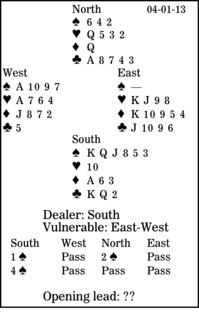Bridge column, April 1: The book says zig; the deal says zag

When a defender has four trumps, it is usually best to try to make declarer ruff something. The defender hopes to reduce declarer's trump length down to his own, or, even better, shorter than his. He wants declarer to lose trump control.
Thinking along those lines, West led the heart ace. When East signaled enthusiastically with the nine, West led another heart. South tried dummy's queen, but East covered with the king.
After ruffing, South was tempted to play on trumps, but he mused about West's lead. West surely had not started with ace-doubleton. And if not, it was a dangerous lead, suggesting that he had long trumps.
Declarer cashed his diamond ace, ruffed a diamond on the board, led a club to his king, and ruffed his last diamond. Then he played a trump. West won and led another heart, but South ruffed, cashed his two top trumps, and played on clubs, still having one trump to retain control. Declarer lost only one heart and two spades.
On this deal, West has to lead his singleton to defeat the contract. Then, if declarer attacks trumps, West wins and returns the suit. Or, if South exits with a heart before or after ruffing a diamond on the board, East wins and gives his partner a club ruff. Then West cashes the spade ace and plays another spade -- no fooling!
** ** **
COPYRIGHT: 2013, UNITED FEATURE SYNDICATE
DISTRIBUTED BY UNIVERSAL UCLICK FOR UFS

